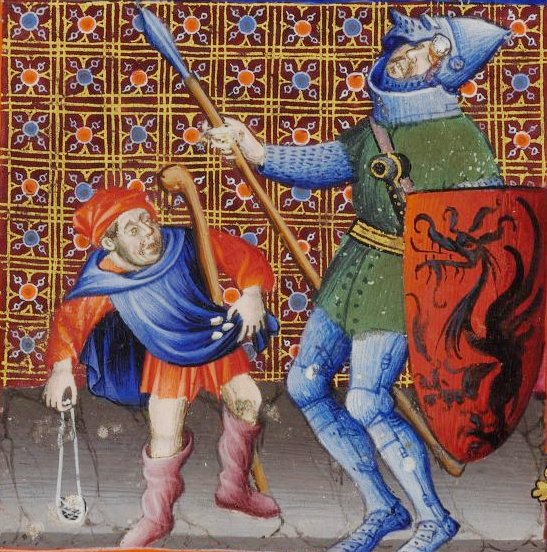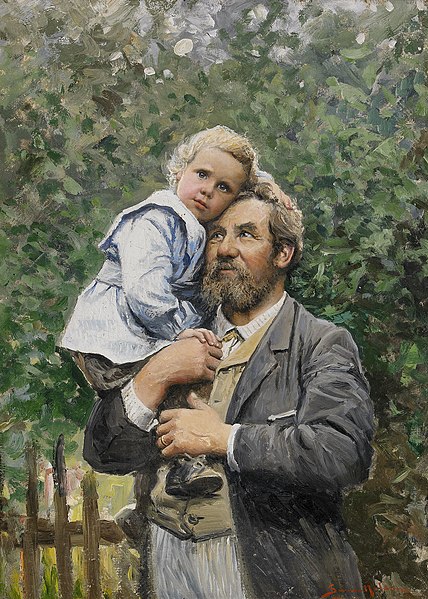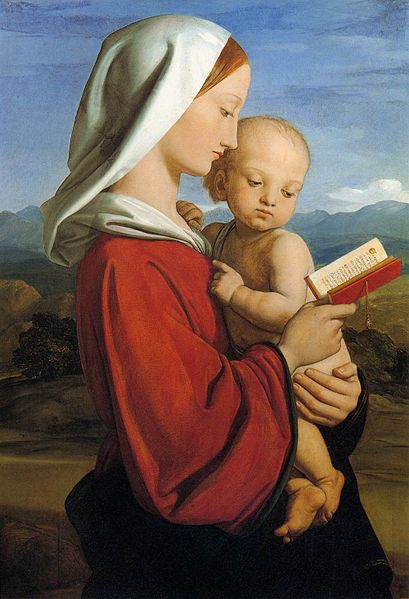Author: Monica @ Catholic Bloggers Network
Pizza and disordered attachments

On Sunday I made pizza for supper. Herbed crust, thick, garlicky sauce, uncured pepperoni, black olives, and two cheeses. Is your mouth watering yet? Is pizza among your disordered attachments?
As you may know, I’m focusing on being more truly detached from everything except God this year. Before you read the rest of this post, you may want to read or review these:
What is detachment in the Catholic spiritual life?Why is detachment necessary?How can you know what your spiritual attachments are?Why do you have inordinate attachments?I can’t work on every possible type of spiritual detachment at once. I have to slice it into small pieces. Here is an easy way I’m trying to start. Every time I experience pleasure or enjoyment, I am immediately turning my thoughts towards God.
As I’ve said before, we are not Puritans. We don’t reject the goodness in God’s creation. The world was damaged by Adam’s fall, but not destroyed.
Enjoying pizza, a good movie, splashing in the rain, or time with your spouse is not sinful. But when we dwell on these pleasures we take them out of their proper context.
Continue reading at Contemplative Homeschool.
TWO NEW Catholic Link-Ups for 2014!
Add your special posts of crafts, activities, festivities and traditions to celebrate the SAINTS each month! Join the Celebrate the Saints Link-Up!
January and February are still open!
Some Marveling at Super-Pope Francis via Graffiti Art
 |
| Artist Mauro Pallotta with his graffiti art “Superpope” Francis (photo: Andreas Dueren/CNA) |
Mauro Pallotta is a 41 year old artist and sculptor based in Rome. But Pallotta may better be known as a celebrated street artist based on widespread notoriety of his graffiti “Super-Pope” Francis on the Via Plauto, a tiny cobble stoned street in the Borgo Pio district near St. Peter’s Square in Rome (Vatican City).
Pallotta (a.k.a. Maupal) was inspired to do the piece one evening when he was reading a comic book and the image of the Pope appeared on television. Pallotta opined:
“I thought of representing this Pope, Francis, as a super hero of the Marvel (Heroes), simply because, according to me, he is one of the few people who, having a real power as a Pope, he uses it for the good like the superheroes of the American Marvel.” It dawned on the artist that this Pope also had superpowers in the form of humility and empathy.
Pallotta likened Super-Pope to “It’s a little bit like Greek mythology brought to modernity.” In depicting Pope Francis as a superhero using his papal authority for the good, the pontiff is shown as a pop style dressed in his understated white cassock, simple shoes and an iron pectoral crosscross as the Super-Pope carrying a black briefcase labeled “Valores” (meaning values in both Latin and Spanish). This symbolizes that the first New World Pope only carries his Christian values.
A red and blue scarf is hanging out of the briefcase, which is for the Argentine San Lorenzo de Football (soccer) club, which the Pope been a fan of this underdog team since his boyhood.
Pope Francis greeted players from San Lorenzo at the Vatican in December after a Wednesday general audience to congratulate them on winning the Tornial Incial championship.
Pope Francis has repeatedly spoken of the spiritual values of sports teams. His Holiness exhorted Argentine and Italians sports clubs that: “[R]ugby is like life because we are all heading for a goal, we need to run together and pass the ball from hand to hand until we get to it”.
The artist explained that the San Lorenzo soccer scarf brought Super-Pope Francis to being human. However, considering Pope Francis’ connection between sports and spirituality, carrying the San Lorenzo scarf with his values “baggage” , it can be seen as a reminder that even a “Super-Pope” needs the support of his underdog team to achieve the goal of advancing the kingdom of God.
Vatican Communications embraced Pallotta’s Super-Pope folk art tribute by posting it on its Twitter feed.
var _gaq = _gaq || []; _gaq.push([‘_setAccount’, ‘UA-21735473-1’]); _gaq.push([‘_trackPageview’]); (function() { var ga = document.createElement(‘script’); ga.type = ‘text/javascript’; ga.async = true; ga.src = (‘https:’ == document.location.protocol ? ‘https://ssl’ : ‘http://www’) + ‘.google-analytics.com/ga.js’; var s = document.getElementsByTagName(‘script’)[0]; s.parentNode.insertBefore(ga, s); })();
Bishop Edward Burns on Faith
Create a guided Christian meditation for kids, step by step
 |
| David and Goliath from the Breviari di Marti, 14th-15th century (photo credit: Wikipedia). |
I’ve had a lot of requests lately, especially since my interview on Carmelite Conversations, for more details on teaching children to pray. So I’ve decided to write a step-by-step post to help you create these meditations for your children or students.
I will walk you through a meditation I created for my boys. We’ll use the story of David and Goliath as a basis for this meditation, because everyone is familiar with it.
You can write a meditation for your kids without first praying over the Scripture passage yourself. I was making a Bible-based curriculum for the boys for a few years before I realized how akin it was to Christian meditation. At that point, I tried meditating on the Scripture passage first. What happened?
The lesson became more personal. I was more excited about it. My kids and I were then focusing on the same things in our spiritual lives. How cool is that? I taught with more enthusiasm and gained a deeper connection with them.
Step 1: Read and Meditate on the story yourselfSo, find a Bible and read I Kings 17. This is a long story, so I encourage you to read it outside your prayer time. You don’t want to spend all your time with God reading. You want to spend your time in conversation with Him.
Then set aside about thirty minutes for prayer, alone in a quiet place where no one will interrupt you. Place yourself in God’s presence. Ask the Holy Spirit to guide your meditation.
Read the rest at Contemplative Homeschool.
Honoring St. Francis de Sales, the Patron Saint of Writers
Today is the feast day of St. Francis de Sales (1567-1622). Francis de Sales was canonized in 1665. St. Francis de Sales was known both for his medium as well as his message. St. Francis de Sales was named a doctor of the Church by Pope Blessed Pius IX in 1877 for works like “An Introduction to a Devout Life”.
In 1924, Pope Pius XII proclaimed St. Francis de Sales the patron saint of writers and journalists (and now bloggers) since he extensively used media (flyers and books in his spiritual direction and his apologetics to convert Calvinists in the region. During his missionary work in Switzerland, Francis de Sales was able to help up to 70,000 people return to the faith. Aside from his prolific wring, St. Francis de Sales was known for his concern for writing with truth and charity. Hence, he is also considered a patron for Christian Unity.
Through your prayers, St. Francis de Sales, I ask for your intercession as I attempt to bring the written word to the world. Let us pray that God takes me in the palm of His hand and inspires my creativity and inspires my success. St. Francis de Sales, you understand the dedication required in this profession. Pray for God to inspire and allow ideas to flow. In His name, let my words reflect my faith for others to read. Amen.
10 ways dads can help their children grow in holiness

Today is my dad’s 75th birthday. I’ve been thinking about my relationship with him a lot lately, especially while writing a chapter on fathers in my upcoming book, Trusting God with St. Therese. Louis Martin was St. Therese’s prime example of God’s character. God made all human fathers to be mediators between Himself and their children. Fathers are the priests of their family.
Here are 10 ways dads can help their children grow in holiness.
Practice authoritative parenting.
Authoritative dads are firm, but affectionate. They discipline when their kids break the rules. They show mercy when their kids are repentant. They kiss owies when moms aren’t available.Love and respect your wife.
Fathers represent God in their families. Mothers represent the Church. Lay down your life for your wife. Tell her you love her often–in front of the kids. Never tolerate a child’s disrespect for her.Be humble.
Don’t pretend you have all the answers. Any kid above 10 knows it isn’t true. Admit your mistakes. Apologize. Take your whole family to Confession.
Read the rest at Contemplative Homeschool.
St. Peter’s Bones : How the Relics of the First Pope were Lost and Found… and than Lost and Found Again
This week over at The Catholic Book Blogger I featured Thomas Craughwell’s latest book St. Peter’s Bones : How the Relics of the First Pope were Lost and Found… and than Lost and Found Again. This was an incredible read that I highly recommend. Below are links to the various articles I posted on it.
See my review here.
See my interview with Thomas Craughwell here.
And last but not least enter to win a copy of St. Peter’s Bones here.
Bible verses for your kids (and you!) to memorize

Reading back over some old posts recently, I realized I had promised to share with you some of the Bible verses we use for memory and copy work in our homeschool. Well, better late than never!
These verses are helpful for adults to know by heart as well as children. They teach about virtue, the importance of prayer, God’s character, and other aspects of the spiritual life.
Over the past several years, our family has experienced the Bible as unit studies. Reading chronologically through the Golden Children’s Bible, I look for themes that can help us bring other subjects into our study of Scripture. (See more details on my homeschooling method here.)
I choose a verse for memorization and handwriting practice. Sometimes the verse comes right from the story. Other times I search through a concordance or consult my memory for a verse that encapsulates one of the themes we are considering.
Read more at Contemplative Homeschool..









